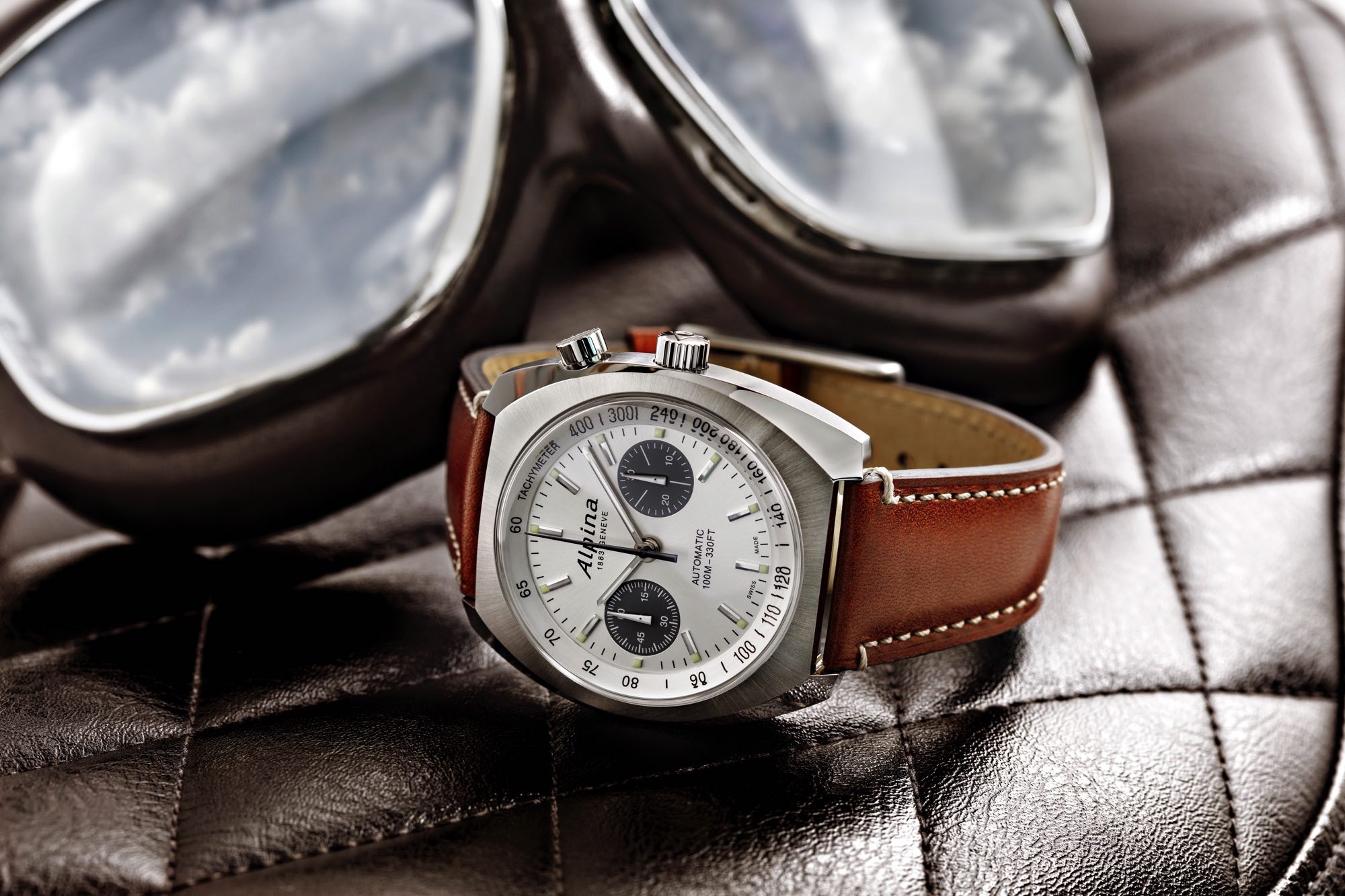Alpina Startimer Pilot Heritage Chronograph Monopusher
Alpina's first mechanical chronograph complication in the Startimer Heritage Pilot family, with a strong 1970s vibe and monopusher functionality.

Alpina expands its 1970s-inspired Startimer Heritage Pilot family with a chronograph. Not just any chronograph, mind you, but a monopusher chronograph based on a movement by La Joux-Perret, not something you would expect to find on a watch retailing for just over EUR 3,000. Presented in three different colourways, the watch has a commanding presence and will appeal to fans of cool, retro-styled sporty chronographs.
Flying on vintage wings
The Startimer family is Alpina’s range of pilot watches and was expanded recently with the Startimer Pilot Heritage sub-collection, a model with a groovy 1970s vibe compounded by its distinctive helmet-styled case. To date, the Heritage family was only represented by the Startimer Heritage GMT watch and the incorporation of a chronograph is most welcome.
For the record, this is not the first chronograph complication for Alpina. The brand already boasts a flyback chronograph with a manufacture movement in its Alpiner family (a movement shared with sister-brand Frederique Constant), but up until today, the Startimer Pilot Heritage was flying solo with a GMT (there is a quartz chrono in the regular Startimer pilot line-up, but that doesn’t count).
A 1970S-inspired Case
All three models share a 42mm stainless steel case with 100m water-resistance that is variously described as a helmet-style case or a combo cushion/bullhead-style case. Looking through the archives, you can see how similar the case is to several Alpina models from the 1970s, including this Alpina chronographs with 7750 or Lemania movements.
Call it what you like, the case has a lot of personality and is nicely finished with polished flanks and a contrasting satin-finished bezel. Just above the screw-down crown at 2 o’clock is the single pusher to activate the chronograph. Alpina’s decision to go for a monopusher, as opposed to a more conventional double pusher chronograph, was to pay tribute to the first Alpina sports chronographs, like this model from the 1920s.
Three colourways
Available in three versions – silver, blue and silver, and blue and silver with red hands – the dials of. the Alpina Startimer Heritage Chronograph feature a bi-compax layout with contrasting colours for the counters (running seconds on the left and 30-minute elapsed time on the right) and a thick tachymeter scale. All three models have applied silver indices with green lume at the tips while the hand-polished hour and minute hands feature white lume. By far the raciest or sportiest model is the blue dial with contrasting silver counters and tachymeter scale and the two chronograph hands picked out in racing red.
Automatic chronograph movement
Monopusher Chronographs are rare, especially on a watch retailing for just over EUR 3,000
Powering the Alpina Startimer Heritage Chronograph is Calibre AL-727, an automatic monopusher chronograph movement based on a movement designed by La Joux-Perret. You can’t see it because it is protected under the screw-down caseback. The decision to source the movement from a third party makes a lot of sense since Alpina, La Joux-Perret and Frederique Constant all belong to the Citizen Group and pooling resources is the surest way to contain prices. To ensure shock-resistance and enhance accuracy, the movement oscillates at a frequency of 28,800vph/4Hz and can supply up to 55 hours of power reserve.
Price
All three references of this Alpina Startimer Heritage Chronograph come with rugged leather straps with contrasting white stitching and retail for EUR 3,090. More information at alpinawatches.com.












5 responses
I like this very much.
It’s a very nice watch
Talk about “damning with faint praise”!
I wonder why this didn’t excite the readers.
Of course if it had said “Rolex” on the dial, there would have been 25 articles about how amazing and radical it is by now.
Really fugly case, that is why they made a great mono pusher at a decent price but that 1970’s looking case ain’t going to look good on anyone who wasn’t alive when that design was in. It was considered ugly back thne, but now, damn. A shame.
For myself the case is a great part of the appeal